Horton and his band, Manager and Bass Player Tillman Franks and Guitarist Tommy Tomlinson, had worked a date at the Skyline Club in Austin, Tx. on Friday night, Nov. 4. About midnight they loaded their gear into Horton's big white Cadillac and started on their journey back to Shreveport, La.
His friend and singing buddy, Claude King, was waiting for Horton at Hall's Brake near Ajax, La. to go duck hunting as that Saturday was the first day of duck season.
At 1:30 a.m. Horton was at the crest of the overpass when he saw a vehicle approaching him. Texas Highway Patrolman Gilbert Smith, who investigated the accident, said the vehicle was three feet in Horton's lane. Smith is now an attorney in Arlington, Tx.
James Evans Davis of Brady, Tx drove the other vehicle. He was a student at Texas A&M University at Bryan, Tx. and was on his way home for the weekend. Testimony showed that Davis had been drinking that day and even had liquor in his vehicle at the time of the wreck.
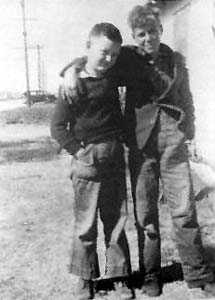
|
|
Circa 1935 |
Horton was born in Los Angeles, Calif. on April 30, 1925. He was named "John Gale." His parents, John Lolly and Ella Claudia Horton, were from the East Texas area. But they were ramblers and often traveled between Texas and California in search of a better life during those hard days.
There were four other children in the family, Fred Browning, Frank, Marie and Nola Bea. Frank and Marie still live today in Crockett, Tx. Fred and Nola Bea are deceased.
The elder Horton was a finished carpenter and a farmer. Mrs. Horton was an accomplished musician and taught piano lessons. At one point they referred to themselves as "fruit traps" since they would pick fruits, vegetables and cotton on their way to California and while there.
In May of 1944, Horton was graduated from Gallatin, Tx. High School. During his early life, in addition to California, the Horton family had lived in the area of Jacksonville, Rusk, Pontai, Noonday and Gallatin in Texas.
Horton entered Lon Morris College in Jacksonville in September 1944. He attended two semesters and was captain of the basketball team, a member of Masque and Wig, the Maverick and also a member of a fraternity. Basketball was also one of his great loves.
On Oct. 1, 1945, Horton enrolled at Kilgore, Tx. Junior College. He only attended one semester.
Fishing had always been his passion. In later 1945 and early 1946, he tested baits, lures and tackle for manufacturers. In the summer of 1945, he, brother Frank and their father spent two weeks in Florida fishing.
During 1946, Horton spent seven months in the Everglades of Florida by himself fishing. It was while there that he wrote his first song entitled, "All For The Love Of A Girl." In late 1946, he returned to California where he and Frank became "Soldiers of Fortune." During this period they turned up in Rusk and also in Florida, returning to California in early 1947.
At that time, Johnny went to work in the mailroom of Selznick Studios in Los Angeles. It was there he met Donna Cook and eventually ended up marrying her toward the end of 1951.
In the summer of 1947, Johnny and Frank left California headed for a construction job in Anchorage, Alaska. Frank decided not to go and stopped off in Seattle, Wash., but Johnny goes on, returning to Seattle in January 1948.
In the fall of 1948, Johnny and Frank enter the University of Seattle, but do not finish the term. In a letter from Seattle dated March 17, 1949, Johnny wrote his parents that he was going to Los Angeles to pick up some spinning reels for testing, was then going to Rusk for a visit and on to Florida. Sometime in 1949, he moved to Los Angeles.
In 1950, Horton moved to Texas and during this time he was encouraged by his sister, Marie, to enter a talent contest at the Reo Palm Isle Club in Longview, Tx. The sponsor of the event was KGRI in Longview and the master of ceremonies was Jim Reeves, who later became a great star in Country Music.
By summer, Horton was back in California and entered a talent contest at Harmony Park Corral in Anaheim. He sung all the 13 songs he knew and won the contest.
By the later summer, Horton had a job singing for the Pet Milk Company doing commercials and promotional packages in California. He had found that you can make money from music. During this period, Horton claimed to have appeared in two movies "The Story of Will Rogers" and "Distant Drums" with Gary Cooper. This has not been verified.
In late 1950 or early 1951, Fabor Robinson becomes Horton's manager. In early 1951, Horton starts a program on KSLA radio in Pasadena, Calif. Sometime that year, Dixie Pelton of Los Angels starts his first fan club, called "Done Rovin'," the name of one of Horton's compositions.
In early 1951, Horton signs with Cormac Record and records his first session in Santa Anna, Calif. The songs were "Plaid and Calico" and "Done Rovin.' " Also that year Horton joined the Hometown Jamboree, a popular Saturday night show, that was also seen on KTLA-TV in El Monte, Calif. The show's proprietor was Cliffie Stone and cast members were Tennessee Ernie Ford and Merle Travis. During that summer, Johnny and Frank shared another vacation in Florida.
Robinson started a record label call Abbott for which to record Horton. In mid-1951, Horton cuts his first session, six songs, in Hollywood. In November, he cuts another six songs for his second session. Later, Robinson signed Jim Reeves to the Abbott label and had some success. He also started a label called "Fabor."
In the summer of 1951, Horton started hosting a show entitled "Hacienda Party Time" on KLAC-TV in Los Angeles. During his program, Horton would do trick casting with his rod and reel, in addition to singing. It was here that he was giving the title, "The Singing Fisherman."
With his Abbott records getting some play, Horton hears home calling and on May 24, 1952 made his first appearance on the popular country music show, the Louisiana Hayride sponsored by KWKH in Shreveport, La., just across the state line from East Texas.
KWKH had started broadcasting in 1925, the same year Horton was born. The Hayride had been in existence since April 3, 1948 and had already created such stars as Hank Williams, Webb Pierce, Slim Whitman and Faron Young. Horton became a regular member.
In June 1952, Horton cut his first session for Dee Kilpatrick of Mercury Records. During his years with Mercury, he cut such songs as "First Train Headed South," "The S.S. Lure Line," "Train With The Rumba Beat" and "All For The Love Of A Girl."
Horton continued appearing regularly on the Hayride, plus working personal appearances wherever he could. In the summer, his wife Donna goes back to California and the marriage ends.
In the summer of 1952, the Opry fires Hank Williams and in October he comes back to Shreveport as a member of the Hayride. He and Horton become friends. Williams is wed to Billie Jean Jones and while listening to Horton's latest, "The Child's Side of Life," tells her the song is no good, but added, "That kid from California is gonna made it one day." Williams died in the back seat of his power blue Cadillac on New Years Day 1953. The hard living and burning the candle at both ends had caught up with him. The candle had burned out.
Later that year, Horton and Robinson find a group called “The Rowley Trio” in Beaumont, Tx. It is made of a husband and wife, Jerry and Evelyn Rowley, Jerry's sister, Dido, and a steel guitar player named, Bob Stegall. They join Horton as his band and call themselves "The Roadrunners." Just after coming to the Hayride, one ad in Tyler, Tx. listed Horton's band as "The Reel 'Em In Boys."
The Jan. 11, 1953 "Shreveport Times" reported three Hayride stars have become recognized nationwide and that Horton had gained wide popularity.
In March 1953, "Billboard" reported that Horton was voted the ninth "Most Promising Country and Western Artist" in their annual poll of disc jockeys.
In March or April, Horton and his manager, Robinson, part company. On May 2, Horton launched a 15-minute Saturday morning radio program on KWKH.
During that summer, Billie Jean Jones Williams and Horton are seen together on a regular basis. On Sept. 26 they are wed in Rusk, Tx. and made their home at 1900 Rodney St. in Bossier City. One of their neighbors is Merle Kilgore, who was a good friend.
Billie Jean's brothers, Al and Sonny Jones, start working as Horton's band.
In early 1954, Dot Barnhart of Longview, Tx. starts a fan club for Horton.
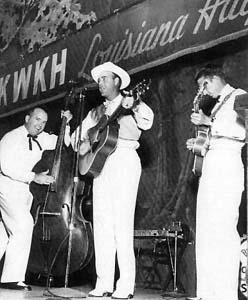
|
|
Tillman Franks - Johnny Horton - Tommy Tomlinson |
Franks was not pleased with the records Horton had been putting out on Mercury. He made arrangements for Horton to get out of his Mercury contract. Franks knew that in order for Horton to succeed, he would have to get on another label and go a different direction musically.
A Columbia contract was obtained for Horton. Franks knew the company was stronger than Mercury and would promote Horton better.
On Nov. 15, 1955, Johnny and Billie Jean's first child, Yanina Eliece, is born.
Horton cuts his first four sides for Columbia on Jan. 10, 1956 at Bradley's Recording Studio in Nashville. The deal is that if the songs don't hit, his contract with Columbia is over.
For the session, Horton and Franks stop in Memphis and ask their friend, Elvis Presley, if they can use his bass player, Bill Black. Presley agrees. When they got to Nashville, Grady Martin was in charge of arranging the session for Columbia's Don Law. They record "Honky Tonk Man." It reaches the charts. They also recorded "I'm A One Woman Man," "I'm Ready If You're Willing" and "I Got A Hole In My Pirogue."
Horton stars on a Monday night television show on KLTV in Tyler, Tx. In April 1956, Gary Bryant of Washington State hitchhiked to Shreveport to try to land a spot on the Hayride. He does a lot of personal appearance tours with Horton.
By this time, Jerry Kennedy, a Byrd High School Student and guitar whiz, is working some with Horton, as well as making a name for himself. Franks has taken Kennedy under his wing and is doing everything he can to help advance his career.
Elvis Presley returned to Shreveport for his final appearance on the Hayride Saturday, Dec. 15, 1956. More than 9,000 attend the show, which was moved to the State Fair's Hirsch Coliseum. Horton is a part of the show.
On Feb. 23, 1957, Horton made his one and only appearance on the Grand Ole Opry. He is on the NBC Radio Network portion sponsored by Prince Albert pipe tobacco and stars Red Foley. Horton sang "One Woman Man" and "I'm Coming Home." Franks said the next day that they worked a date at Roy Acuff's Dunbar Cave at Clarksville, Tenn.
KSLA-TV in Shreveport started a 15-minute show entitled "Hayride" on June 3, 1957 and Horton appeared on the program several times, along with other Hayride artists.
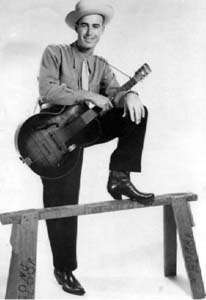
|
|
|
While Franks headed the Bureau, he used his position to promote Horton to the fullest extent.
Horton continued recording for Columbia, but that big hit continued to elude him. He went back in the studio Nov. 10, 1958 and cut a tune that he and Franks had written entitled "When It’s Springtime In Alaska." It became a big hit and finally, Horton was on his way to the top. They thought the song was a big hit, but the big one had not yet arrived.
In 1958, Jimmie Driftwood had recorded an album for RCA-Victor entitled, "Newly Discovered Early American Folk Songs." Driftwood was an educator in the Ozark Mountains of Arkansas and an educator. In 1939, he said he had taken the old song "The Eighth Day of January" and put words to it to help his students learn history. He said they loved the song because it had the words "damn" and "hell" in it. He called the song, "The Battle of New Orleans."
Tillman heard Driftwood's version of the record and it did something to him. He had a dream one night that he heard Horton singing the song on Ralph Emery's all night show on WSM Radio. Franks said he called Horton the new morning and said he had their next hit.
Jan. 27, 1959 found them in the studios in Nashville recording the song. Franks said when they were finished, he knew it was a hit. The song took off and went to No. 1 in both the Country and Pop fields. Horton was in much demand. The record sold more than 2 million copies in just a short period and continues to sell today. On June 6, "The Battle" had made it to No. 1 on the Country Charts and stayed there for six weeks until July 18.
The monster hit brought Horton offers to appear on The Ed Sullivan Show, The Dick Clark Show and the Ozark Jubilee.
On March 2, 1959, Billie Jean had their second daughter, named Melody.
Saturday, June 13, 1959 was designated Johnny Horton Homecoming in Shreveport. Mayor Clyde Fant gave Horton a proclamation and said he was proud of him. That night Horton headlined the Hayride, his first appearance since "The Battle" hit eight weeks earlier. A packed auditorium gave Horton a hero's welcome and Columbia Records presented a gold record for a million sales. It would not be long before they presented him a double gold record for two million sales.
Horton had always wanted to do a few things and with the money for "The Battle," he got started spending. First he and Billie Jean purchased a new home at 1610 Audubon Place in Shreveport.
Being the fisherman that he was, Horton always wanted to open a factory to manufacture fishing lures. He opened Cane River Bait Co. in Nachitoches, La. in the Spring of 1959. He manufactured his most popular lure called "Ole Fire Ball." In addition, Horton created another bait called "Gallopin' A."
Horton started another business he called "Conversational Pieces, Inc." It was to build unusual decorative items, including cast metal fighting roosters and an ashtrays with large misquotes and ants on them.
Both businesses never really got of the ground and ended up in bankruptcy after Horton's death.
On July 1, 1959, Horton recorded for Columbia, this time a song his friend Merle Kilgore had written, "Johnny Reb." The song became very popular and Horton went to Houston, Tx. and sang the song to General Walter Williams, the last surviving Confederate soldier.
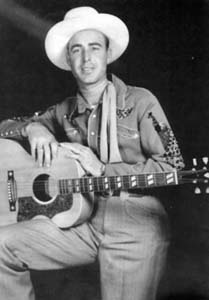
|
|
|
Horton was back in the studio Jan 7, 1960 to record "Sink The Bismark," which he and Franks had written. The song was especially written and used in a movie by the same name.
Sadness struck Horton Aug. 3, 1959 when his father, John Lolly Horton, died of a heart attack in Rusk, Tx. The Rev. Billy Franks, brother of Tillman, conducted the services.
Horton's next big number was "Johnny Freedom," a song written by pop writer Jule Styne. Horton recorded the song March 11, 1960 and later in the summer was honored at the new theme park, “Freedomland" in the Bronx, N. Y.
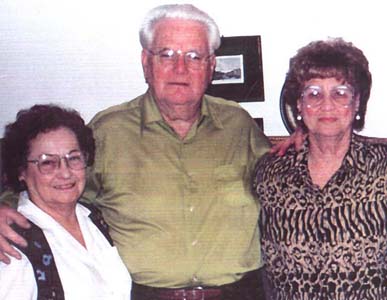
|
|
|
After three sessions, Horton finally got a cut of "North To Alaska" on Aug. 9, 1960 that was acceptable. The number was used as the title song for the movie by the same name. The movie featured John Wayne and Fabian. It was another hit for Horton.
Country Music fans the world over were sadden at Horton's death in 1960. He had worked hard and long on his career and he was at the top.
His music fit into many categories. He is perhaps best remembered as the singer of saga songs. But he was also a rock and roller, a hillbilly and a singer of country songs.
Horton's music today is as fresh as it was when it was recorded all those years ago. Johnny Horton is gone, but his music and his memory continue to live on.